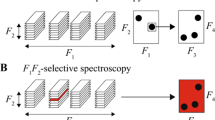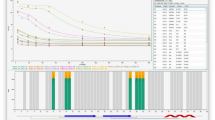Abstract
Improvements are described in a shuttling field-cycling device (Redfield in Magn Reson Chem 41:753–768, 2003), designed to allow widespread access to this useful technique by configuring it as a removable module to a commercial 500 MHz NMR instrument. The main improvements described here, leading to greater versatility, high reliability and simple construction, include: shuttling provided by a linear motor driven by an integrated-control servomotor; provision of automated bucking magnets to allow fast two-stage cycling to nearly zero field; and overall control by a microprocessor. A brief review of history and publications that have used the system is followed by a discussion of topics related to such a device including discussion of some future applications. A description of new aspects of the shuttling device follows. The minimum round trip time to 1T and above is less than 0.25 s and to 0.002 T is 0.36 s. Commercial probes are used and sensitivity is that of the host spectrometer reduced only by relaxation during travel. A key element is development of a linkage that prevents vibration of the linear motor from reaching the probe.





Similar content being viewed by others
References
Amero C, Schanda P, Ascunsion Dur A, Iyala I, Marion D, Franzetti B, Brutscher B, Boisbouvier J (2009) Fast two-dimensional NMR spectroscopy of high molecular weight assemblies. J Am Chem Soc 131:3448–3449
Batnagar J, Borbat P, Pollard A, Bilwes A, Freed J, Crane B (2010) Structure of the ternary complex formed by a chemotaxis receptor signaling domain, the CheA histidine kinase, and the coupling protein CheW as determined by pulsed ESR spectroscopy. Biochemistry 49:3824–3841
Borbat P, Freed J (2007) Measuring distances by pulsed dipolar ESR spectroscopy: spin-labeled histidine kinases in two component signaling systems. In: Simon M, Crane B, Crane A (eds) Methods in enzymology, vol 423. Elsevier, pp 52–116
Brown M, Ribiero A, Williams G (1983) New view of lipid bilayer dynamics from 2H and 13C NMR relaxation time measurements. Proc Natl Acad Sci USA 80:4325–4329
Callabero-Manrique E, Bray J, Deutschman W, Dahlquist F, Guenza M (2007) A theory of protein dynamics to predict NMR relaxation. Biophys J 93:4128–4140
Chou C-Y, Chu M, Chang C-F, Huang T-h (2011) A compact high-speed mechanical sample shuttle for field-dependent high-resolution solution NMR. J Magn Reson. doi:10.1016/j.jmr.2011.12.001
Clarkson M, Lei M, Eisenmesser E, Labeikovsky W, Redfield A, Kern D (2009) Mesodynamics in the SARS nucleocapsid measured by NMR field cycling. J Biomol NMR 45:217–225
Clore M, Gronenborn A (1982) Theory and applications of the transferred nuclear Overhauser effect to the study of the conformations of small ligands attached to proteins. J Magn Reson 48:402–417
Clore M, Iwahara J (2009) Theory, practice, and applications of paramagnetic relaxation enhancement for the characterization of transient low-population states of biological macromolecules and their complexes. Chem Rev 109:4108–4139
Da Costa G, Mouret L, Chevanc S, Le Rumeur E, Bondon A (2007) NMR of small molecules interacting with lipids in small unilamelar vesicles. Eur Biophys J 36:933–942
De Angelis A, Jones D, Grant C, Park S, Mesleh M, Opella S (2005) NMR experiments on aligned samples of membrane proteins. In: James T (ed) Methods in enzymology, vol 394. Elsevier, pp 350–382
Diakova G, Goddard Y, Korb J-P, Bryant R (2010) Water and backbone dynamics in a hydrated protein. Biophys J 98:138–146
Dolainski C, Unger M, Bloom M, Bayerl T (1985) Two-dimensional exchange 2H NMR experiments of phospholipid bilayers on a spherical solid support. Phys Rev E 51:4743–4750
Ferrante G, Sykora S (2004) Technical aspects of fast field cycling. In: van Edik R, Bertini I (eds) Advances in inorganic chemistry, vol 57. Academic Press, pp 405–470
Gaede H, Gawrisch K (2003) Latteral diffusion of lipid, water, and a hydrophobic drug in multilamellar liposomes. Biophys J 85:1734–1740
Grosse S, Gubaydullin F, Scheelken S, Vieth H-M, Yurkovskaya A (1999) Field cycling by fast NMR probe transfer: design and application in field-dependent CIDNP experiments. Appl Magn Reson 17:211–225
Gueron M (1975) Nuclear relaxation in macromolecules by paramagnetic Ions: a novel mechanism. J Magn Reson 19:58–66
Hallock K, Wildman K, Lee D-K, Ramamoorthy A (2002) An innovative procedure using a sublimable solid to align bilayers for solid-state NMR studies. Biophys J 82:2499–2503
Hecht R, Redfield A (1963) Overhauser effect in metallic lithium and sodium. Phys Rev 132:972–977
Ivanov D, Redfield A (2004) Field cycling method with central transition readout for pure quadrupole resonance detection in dilute systems. J Magn Reson 166:19–27
Kang C, Vanoye C, Welch R, Van Horne W, Sanders C (2010) Functional delivery of a membrane protein into oocyte membranes using bicelles. Biochemistry 49:632–655
Kerwood D, Bolton P (1987) A sample shuttling device suitable for two-dimensional low-field NMR. J Magn Reson 75:142–146
Kimmich R, Estaban A (2004) Field cycling NMR relaxometry. Prog NMR Spectrosc 44:257–320
Klauda J, Eldho N, Gawrisch K, Brooks B, Pastor R (2008a) Collective and noncollective modes of NMR relaxation in lipid vesicles and multilayers. J Phys Chem B112:5924–5929
Klauda J, Roberts M, Redfield A, Brooks B, Pastor R (2008b) Rotation of lipids in membranes: MD simulation, 31P spin-lattice relaxation, and rigid-body dynamics. Biophys J 94:3074–3083
Koenig S, Brown R (1990) Field cycling relaxometry of protein solutions and tissues: implications for MRI. Prog NMR Spectrosc 22:487–567
Korchak S, Kiryutin A, Ivanov K, Yurkovskaya A, Grishin Y, Zimmermann H, Vieth H-M (2010) Low-field, time-resolved dynamic nuclear polarization with field cycling and high-resolution NMR detection. Appl Magn Reson 37:515–537
Krahn A, Lottman P, Marquardsen T, Tavernier A, Turke M-T, Reese M, Leonov A, Bennati M, Hoefer P, Engleke F, Griesinger C (2010) Shuttle DNP spectrometer with a two-center magnet. Phys Chem Chem Phys 12:5830–5840
Lane AN, Jenkins T, Brown T, Neidle S (1991) Interaction of beneril with the EcoRI dodecamer d(CGCGAATTCGCG)2 in solution studied by NMR. Biochemistry 30:1372–1385
Leftin A, Brown M (2011) An NMR database for simulations of membrane dynamics. Biochem Biophys Acta 1808:818–839
Legget J, Hunter R, Granwehr J, Panek R, Linde A, Horsewill J, Mcmaster J, Smith G, Kockenberger W (2010) A dedicated spectrometer for dissolution DNP NMR spectroscopy. Phys Chem Chem Phys 12:5883–5892
Lin J, Abaygunawardana C, Frick D, Bessman M, Mildvan A (1997) Solution structure of the quarternary Mut-T-M2+ complex and mechanism of its pyrophosphohydrolase reaction. Biochemistry 36:1199–1211
Lurie D, Aime S, Baroni S, Booth N, Broche L, Choi C-H, Davies G, Ismail S, ǑhǑgain D, Pine K (2010) Fast field-cycling magnetic resonance imaging. Compt Rend Physique 11:136–148
Palmer AG III (1997) Probing molecular motion by NMR. Curr Opin Struct Biol 7:732–737
Pileio G, Carravata M, Levitt M (2010) Storage of nuclear magnetism as long-lived singlet order in low magnetic field. Proc Natl Acad Sci USA 107:17136–17139
Pu M, Fang X, Gershenson A, Redfield A, Roberts M (2009a) Correlation of vesicle binding and phospholipid dynamics with phospholipase C activity: insights into phosphatidylcholine activation and surface dilution inhibition. J Biol Chem 284:16099–16107
Pu M, Feng J, Redfield A, Roberts M (2009b) Enzymology with a spin-labeled phospholipase C: soluble substrate binding by 31P NMR from 0.005 to 11.7 Tesla. Biochemistry 48:8282–88284
Pu M, Orr A, Redfield A, Roberts M (2010) Defining specific lipid binding sites for membrane-bound phospholipase C, by 31P NMR from 0.005 to 11.7 T. J Biol Chem 285:26916–26922
Raschle T, Hiller S, Etzkorn M, Wagner G (2010) Nonmicellar systems for solution NMR spectroscopy of membrane proteins. Curr Opin Struct Biol 20:471–479
Redfield A (2003) Shuttling device for high-resolution measurements of relaxation and related phenomena in solution at low field, using a shared commercial 500 MHz NMR instrument. Magn Reson Chem 41:753–768
Roberts M, Redfield A (2004a) High-resolution 31P field cycling NMR as a probe of phospholipid dynamics. J Am Chem Soc 126:13765–13777
Roberts M, Redfield A (2004b) Phospholipid bilayer surface configuration probed quantitatively by 31P field-cycling NMR. Proc Natl Acad Sci USA 101:17066–17071
Roberts M, Cui Q, Turner C, Case D, Redfield A (2004) High-resolution field-cycling NMR studies of a DNA octamers as a probe of phosphodiester dynamics and comparison with computer simulation. Biochemistry 43:3637–3650
Roberts M, Mohanty U, Redfield A (2009) Phospholipid reorientation at the lipid/water interface measured by high resolution field cycling 31P NMR spectroscopy. Biophys J 97:132–141
Shi X, Shao C, Zhang X, Zambonelli C, Redfield A, Head J, Seaton B, Roberts M (2009) Modulation of Bacillus thuringiensis phosphatidylinositol-specific phospholipase C activity by mutations in the putative dimerization interface. J Biol Chem 284:15607–15618
Sivanandam V, Cai J, Redfield A, Roberts M (2009) Phosphatidylcholine “wobble” in vesicles assessed by high-resolution 13C field cycling NMR spectroscopy. J Am Chem Soc 131:3420–3421
Sousa D, Fernandes G, Marques G, Ribiero A, Sebastiaou P (2004) Novel pulsed switched power supply for a fast field cycling NMR spectrometer. Solid State NMR 25:160–166
Strombotne R, Hahn E (1964) Longitudinal nuclear spin–spin relaxation. Phys Rev A 133:1616–1629
Victor K, Kavolius Y, Bryant R (2004) Magnetic relaxation dispersion probe. J Magn Reson 171:253–257
Victor K, Van-Quynh A, Bryant R (2005) High frequency dynamics in hemoglobin measured by magnetic relaxation dispersion. Biophys J 88:443–454
Wang Y, Chen W, Blair D, Pu M, Xu Y, Miller S, Redfield A, Chiles T, Roberts M (2008) Insights into the structural specificity of the cytotoxicity of 3-deoxy-phosphatidylinositols. J Am Chem Soc 130:7746–7755
Weitekamp DP, Zax D, Zilm K, Pines A (1983) Zero field magnetic resonance. Phys Rev Lett 50:1807–1810
Acknowledgments
This development was supported by National Institutes of Health grant GM077974, and, previously, grant CHE-0109575 from the National Science Foundation Chemical Instrumentation Program, and grant 36680-ACF from the American Chemical Society Petroleum Research Fund. Marcel Reese suggested the use of a servomotor, and its supplier, for this device. We thank our research collaborators, especially Mary Roberts, for performing much of the research reviewed here, and helping prepare the figures. David Roberts provided the photographs, and Thomas Pochapsky kindly read this manuscript. We received much technical help from many individuals in building this shuttler, especially from Frank Mello who fabricated parts for us as well as providing many useful suggestions, and Annemarie Rom-Weisenbach for expert programming. We thank Tai-huang Huang for sending us the recent paper describing the new shuttle design (Chou et al. 2011).
Author information
Authors and Affiliations
Corresponding author
Rights and permissions
About this article
Cite this article
Redfield, A.G. High-resolution NMR field-cycling device for full-range relaxation and structural studies of biopolymers on a shared commercial instrument. J Biomol NMR 52, 159–177 (2012). https://doi.org/10.1007/s10858-011-9594-1
Received:
Accepted:
Published:
Issue Date:
DOI: https://doi.org/10.1007/s10858-011-9594-1




